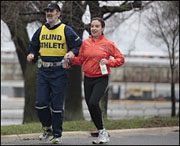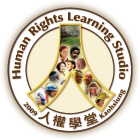
|
 A blind man's triathlon pursuit
A blind man's triathlon pursuit
We tend to frame this country's fitness and obesity problem almost entirely in terms of lifestyle and motivation. Even the most out-of-shape, time-pressed couch potato can find some way to start exercising, we say. You make it a priority, get up and do it.
I've written words to that effect any number of times. It took Doug Powell to remind me, to my embarrassment, that it's not always that simple.
Powell, 60, of Falls Church, is working out twice a day as he prepares for a full Ironman triathlon in Wisconsin this September. Six days a week, he swims, runs or bikes for as much as an hour in the morning and another hour in the afternoon. On weekends, he does long runs and even longer bike rides. No lack of motivation there.
But Powell is almost completely blind. When he wants to run on the roads, he needs a partner who is in roughly the same shape or willing to stick to his pace, tethered to his wrist by a bright orange shoelace. When he wants to cycle, he needs someone on the front of his tandem bike. When he wants to swim anywhere but the pool, he must be tied at the waist to another swimmer. There are watches that call out his pace, time and distance, but they don't work in the water, or even when he sweats.
In fact, unless Powell can persuade USA Triathlon to change its rules, his time in the 2.4-mile swim, 112-mile bike ride and 26.2-mile run won't even count. The organization requires that disabled people complete the event, which Powell estimates will take him about 15 hours, with one partner, not one for each segment.
Powell, who started losing his sight to retinitis pigmentosa at age 10, is matter-of-fact about the obstacles he surmounts every day while you and I go for a quick jog or drive to the gym without a second thought.
"You've got to be flexible," he says. "That's the bottom line to doing adaptive sports."
"I have to, in advance, set up somebody to give me a ride to where the workout is. It may or may not be the same person who does the workout with me.
"They have to run at my pace. If I'm having a good day, they may have to make sure that they can keep up with me, and if I'm having a lousy day, they have to slow down and walk with me. They can't just say 'well so long, I'll see you at the end.' "
According to the 2000 Census, 49.7 million Americans are blind, in wheelchairs or otherwise physically or mentally impaired. And yet, 20 years after the passage of the Americans With Disabilities Act, the fitness needs of the disabled are only beginning to be addressed.
A 2005 survey in the American Journal of Public Health examined 35 for-profit and non-profit health clubs and found that every one presented significant obstacles to disabled people. Some had barriers that kept them from reaching the equipment. Others had equipment that could not be used by people with various types of disability.
"When we think about creating physical fitness facilities, we need to start with realizing that the population ranges from able-bodied . . . to people who have disabilities, to people who are aged, to people who have cognitive disabilities. They should be able to access those facilities and find the support they need to pursue a healthy lifestyle," says Joseph Canose, vice president for quality of life at the Christopher and Dana Reeve Foundation. The group has distributed $13 million in grants since 1999 to create adaptive sports programs for people with spinal cord injuries.
(2010-03-17 / The Washington Post )
|





